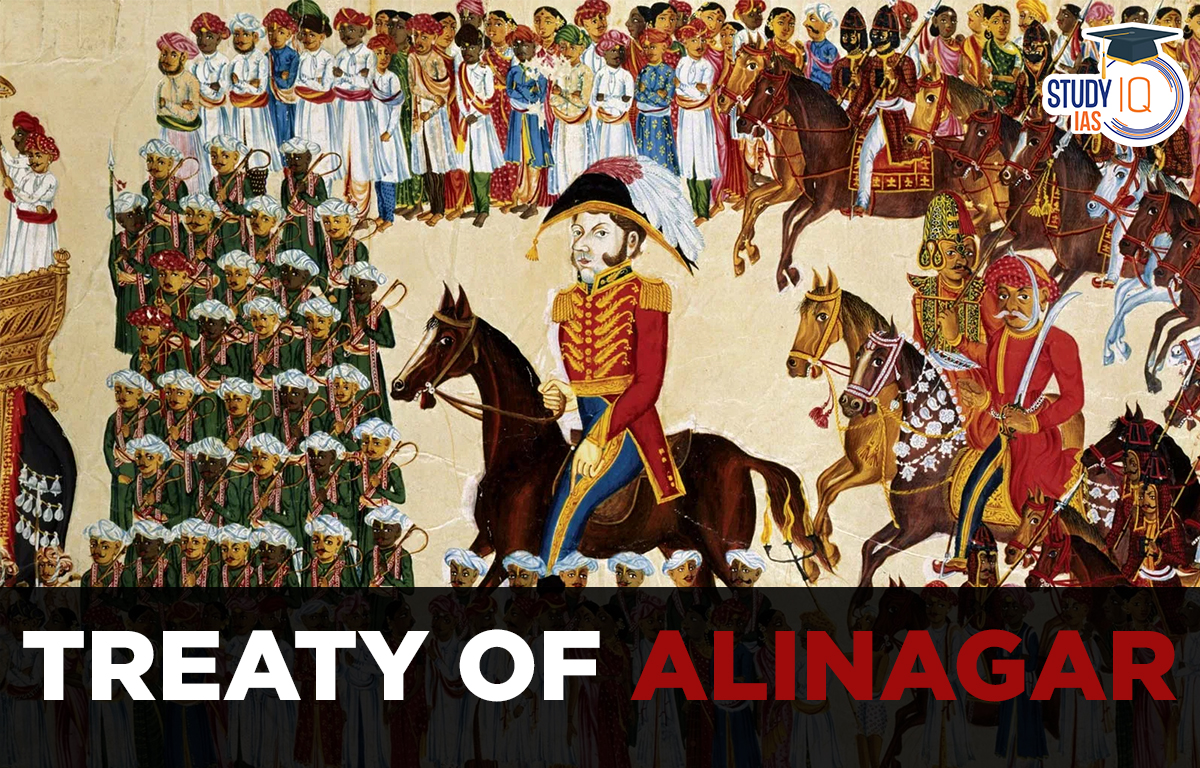Table of Contents
Context: British colonial expansion in India began with the signing of the Treaty of Alinagar on February 9, 1757, between the Nawab of Bengal and the East India Company.
A Brief Overview of the Events that led to the Treaty of Alinagar
- The rise of the East India Company: The Company formally began trading with India in 1613, supported by a royal farman from Mughal emperor Jehangir. Over the course of time, the company gradually expanded its activities, establishing a number of trading posts throughout the country.
- Decline of the Mughal Empire: The death of Aurangzeb in 1707 created a power vacuum in India, leading to a period of political instability and weakened central authority. This provided opportunities for the East India Company to expand their influence and power in the region.
- Farrukhsiyar’s farmaan: Mughal Emperor Farrukhsiyar granted a farmaan to the East India Company in the year 1717, which is regarded as Magna Carta.
- However, some East India Company officials misused the farmaan to gain greater power and influence in Bengal and the surrounding regions.
- This led to widespread corruption and abuse of power, which strained the relationship between the Bengal Nawabs and the East India Company.
- The rift between Murshid Quli Khan and the company: Nawab Murshid Quli Khan, the new autonomous ruler of Bengal, refused to extend the 1717 farmaan’s duty-free provision to cover the private trade of the Company officials.
- He also denied permission to the Company to buy the thirty-eight villages and refused to offer minting privileges to the British.
- Over time, this would be a source of constant acrimony between the Nawab and the Company, starting its troubles in Bengal.
- It led to the realization that controlling territory was necessary for expanding British business in India and achievable due to the subcontinent’s fragmented political landscape.
- Capturing of Calcutta by Siraj ud Daula: In 1755, vary of French competition, the English began renovating the fortifications in Calcutta without the Nawab’s permission.
- Matters took a turn for the worse in 1756 when an Indian trader named Krishna Ballabh took refuge inside the renovated Fort William in Calcutta.
- When the Company failed to listen to warnings, Siraj showed his strength by taking over the Company factory at Cossimbazar.
- A few weeks later, the Nawab’s forces would attack Fort William, capturing Calcutta on June 20. They would ransack the city and the Nawab would shortly rename it Alinagar.
About the Treaty of Alinagar
- The course of the treaty:
- Nawab’s weak position: In spite of Siraj ud Daula’s easy takeover of Calcutta, his position was much weaker than it appeared.
- The Afghan threat: The nawab was also facing the threat of the Afghans under Ahmad Shah Abdali who had already caused havoc in the Northern territories of the weak Mughal Empire.
- Attack by Robert Clive: A surprise attack by the Company forces under Robert Clive defeated the Nawab’s forces outside Calcutta in early 1757.
- Signing the treaty: The threat of an impending Afghan assault and under advice from his ministers, the Nawab reluctantly decided to sign a treaty with the Company on February 9, 1757: the Treaty of Alinagar.
- Features of the treaty: This treaty restored all the privileges that Farrukhsiyar’s 1717 farmaan had granted to the East India Company, allowing it to carry out duty-free trade, build further fortifications and operate a mint.
- Significance of the treaty:
- The story of the Treaty of Alinagar is a story of the eventual rise of the East India Company as a political force to be reckoned with.
- Though the treaty maintained the sovereignty of the Nawab of Bengal, its terms were extremely favourable to the Company. This was not only embarrassing for the Nawab but also empowering for the Company.
Conclusion
- For most Indians, the history of British colonial rule in India begins in the Battle of Plassey (on 23 June 1757).
- However, the roots of it were sown long back. While the Treaty of Alinagar itself might be relegated to a minor footnote in history, understanding what led up to it provides much greater perspective of the machinations of early colonial expansion in India


 National Technology Readiness Assessment...
National Technology Readiness Assessment...
 Justice Mission-2025: China’s Live-Fir...
Justice Mission-2025: China’s Live-Fir...
 Suryastra: First Made-in-India Long-Rang...
Suryastra: First Made-in-India Long-Rang...

























